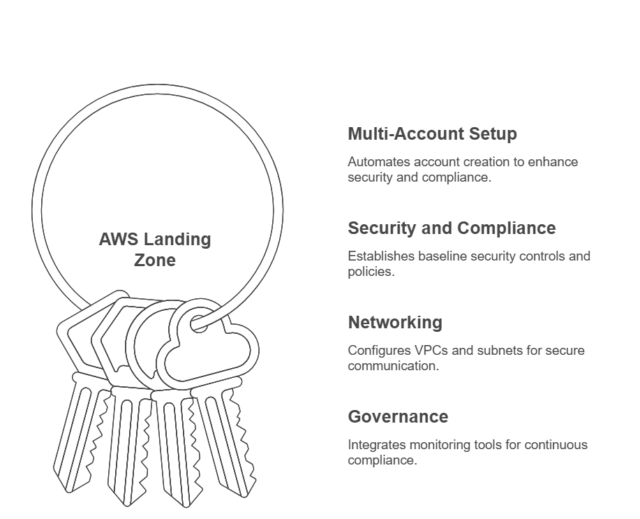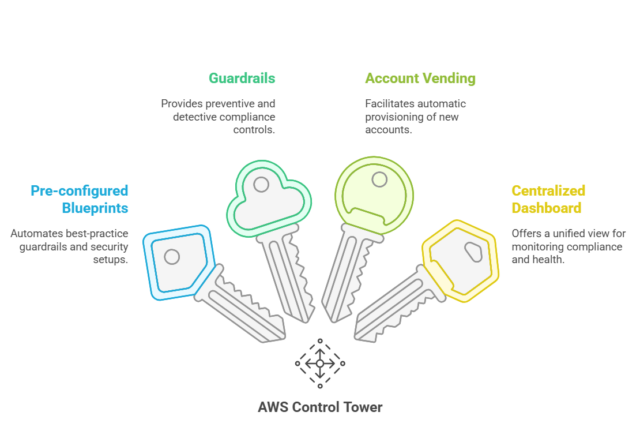Introduction
As organizations migrate to the cloud, managing multiple AWS accounts and ensuring consistent governance and security can become a complex task. AWS provides tools like AWS Landing Zone and AWS Control Tower to simplify the process of setting up a secure and scalable multi-account AWS environment. This blog explores both solutions, comparing their features, use cases, and how they can help organizations manage their cloud infrastructure effectively.

What is AWS Landing Zone?
AWS Landing Zone is a set of best practices and automated configurations to set up a secure, multi-account AWS environment based on AWS’s Well-Architected Framework. It helps establish an initial cloud foundation by implementing essential services for security, governance, and networking across multiple AWS accounts.
Key Features of AWS Landing Zone:
- Multi-Account Setup: Automates the creation of multiple accounts to isolate workloads for better security and compliance.
- Security and Compliance: Implements baseline security controls, including IAM roles and policies, logging, and encryption.
- Networking: Sets up VPCs, subnets, and security groups to enable secure communication across accounts.
- Governance: Integrates with AWS Config, CloudTrail, and CloudWatch for continuous monitoring and compliance.
When to Use AWS Landing Zone:
AWS Landing Zone is ideal for organizations that want to establish a robust cloud environment with automated security and compliance practices but may require more customization and flexibility in terms of configuration.

What is AWS Control Tower?
AWS Control Tower is a fully managed service that simplifies the setup and governance of a secure, multi-account AWS environment. It builds on AWS Landing Zone, automating much of the configuration process and providing a central management dashboard for monitoring compliance, security, and account lifecycle.
Key Features of AWS Control Tower:
- Pre-configured Blueprints: Automates the setup of best-practice guardrails, account structures, and security configurations.
- Guardrails: Offers a set of preventive and detective controls to ensure compliance with security and governance policies.
- Account Vending: Automatically provisions new accounts in the environment with pre-configured settings.
- Centralized Dashboard: Provides a single view for managing and monitoring the compliance and health of the AWS environment.
When to Use AWS Control Tower:
AWS Control Tower is best suited for organizations that need a quick, automated setup with governance and compliance management out-of-the-box. It’s ideal for teams looking for ease of use without heavy customization.

Key Differences: AWS Landing Zone vs. AWS Control Tower
| Feature | AWS Landing Zone | AWS Control Tower |
| Setup Process | More manual and customizable | Fully automated with pre-configured blueprints |
| Governance | Customizable governance with AWS services | Pre-configured guardrails and centralized management |
| Account Management | Manual account creation and configuration | Automated account vending and management |
| Customization | Highly customizable for specific use cases | Limited customization, more prescriptive |
| Complexity | Requires more expertise and effort | Easier to set up with minimal effort |
When Do You Need AWS Landing Zone or AWS Control Tower?
- For Customization vs. Convenience
- AWS Landing Zone is suitable for organizations that need full control over their AWS environment and want to customize configurations.
- AWS Control Tower is ideal if you want an easy, automated setup with minimal effort and don’t need extensive customization.
- For Automated Governance
- AWS Control Tower provides a comprehensive, automated governance framework with guardrails that help enforce security and compliance without manual intervention.
- If you need custom governance tailored to your organization’s needs, AWS Landing Zone is the better choice.
- For Centralized Monitoring
- If you need centralized monitoring, AWS Control Tower provides an intuitive dashboard to monitor all AWS accounts.
- AWS Landing Zone requires setting up monitoring tools manually, giving you more control but requiring additional setup.
- For Multi-Account Management
- If managing multiple AWS accounts is critical, AWS Control Tower simplifies the process with automated account provisioning and management.
- AWS Landing Zone allows you to manage accounts manually but offers more flexibility in how accounts are structured.
Conclusion
Whether you choose AWS Landing Zone or AWS Control Tower largely depends on your organization’s need for customization versus simplicity. If you are looking for a more hands-on, customizable approach, Landing Zone offers the flexibility to adapt to complex use cases. However, if you want an easier, automated setup with built-in governance and compliance features, Control Tower is the way to go.
